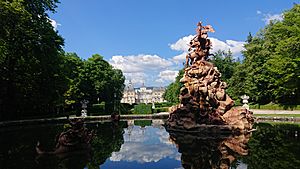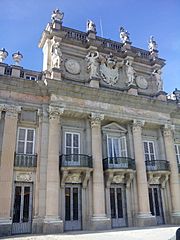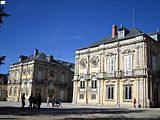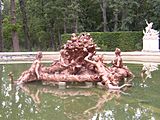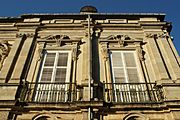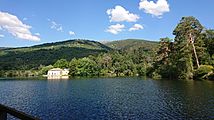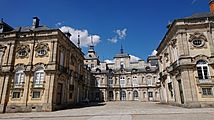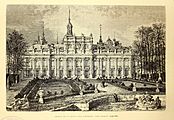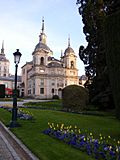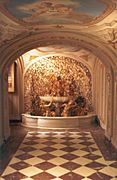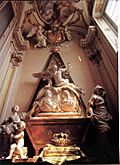Royal Palace of La Granja de San Ildefonso facts for kids
Quick facts for kids Royal Palace of La Granja de San Ildefonso |
|
|---|---|
|
Palacio Real de La Granja de San Ildefonso
|
|
 |
|
| General information | |
| Architectural style | Rococo |
| Location | Real Sitio de San Ildefonso (Segovia), Spain |
| Construction started | 1721 |
| Opened | Exclusive property for the monarch: 1724 |
| Management | Patrimonio Nacional |
| Technical details | |
| Size | 25,000 square metres (270,000 sq ft) |
| Grounds | 146 hectares (360 acres) of gardens |
| Design and construction | |
| Architect | Teodoro Ardemans |
| Official name | Palacio de San Ildefonso con sus dependencias y Jardines |
| Type | Non-movable |
| Criteria | Monument |
| Designated | 11 August 1925 |
| Reference no. | RI-51-0000314 |
| Official name | Jardines del Palacio de San Ildefonso |
| Type | Non-movable |
| Criteria | Historic Garden |
| Designated | 3 June 1931 |
| Reference no. | RI-52-0000002 |
The Royal Palace of La Granja de San Ildefonso, often called La Granja, is a beautiful palace from the early 1700s. It is located in the small town of San Ildefonso, in the hills near Segovia, Spain. This grand palace is about 80 kilometers (50 miles) north of Madrid.
La Granja became the summer home for the kings of Spain starting in the 1720s. King Philip V was the first to use it. The palace has a calm Baroque style. It is surrounded by huge gardens designed in the formal French style, complete with amazing fountains. Today, you can visit La Granja as a museum.
Contents
History of La Granja Palace
The area where La Granja stands was a favorite hunting spot for many kings from the Kingdom of Castile. This was because of its location on the forested slopes of the Sierra de Guadarrama mountains. In the 1400s, King Henry IV of Castile built the first hunting lodge here. He also built a small church dedicated to Saint Ildephonsus of Toledo, which gave the place its first name.
Later, Queen Isabella I of Castile gave these buildings to the monks of the Santa Maria del Parral monastery in Segovia. The monks built a place for the poor and started a granja (farm) next to the lodge and church.
How the Palace Was Built
King Philip V bought the land from the monks in 1719. This happened after his nearby summer home, the Palace of Valsain, was destroyed by fire. Philip V was the first Spanish king from the French Bourbon dynasty. Starting in 1721, he began building a new palace and gardens. He wanted them to be like Versailles, which was built by his grandfather, Louis XIV of France.
Like Versailles, La Granja had a special courtyard at the entrance. It also featured formal gardens with a main path leading to the palace. These gardens were surrounded by woods, where more hidden garden features were placed. Just like Versailles, La Granja started as a quiet getaway. However, it soon became an important center for the royal government.
For the palace's design, Philip first chose a simple plan by Spanish architect Teodoro Ardemans. This plan included a chapel in the center of one side. The palace was made bigger between 1728 and 1734 by Andrea Procaccini and Sempronio Subisati. They added courtyards on the sides. The final look was given by Filippo Juvarra, who came from Turin. His assistant was Giovanni Battista Sacchetti.
A Royal Retreat Becomes a Center of Power
When King Philip V decided to step down from the throne in 1724, he planned to live at La Granja. But his son, King Louis I, sadly died that same year. This meant Philip had to become king again. So, a place meant for relaxation became an important meeting spot for the King, his ministers, and the court.
The town of San Ildefonso grew to provide homes and services for the courtiers. They all wanted to live near the king's favorite residence. Military barracks, a church (built 1721–1724), and even a royal glass factory (1728) were built to support the palace. The glass factory, which had started in 1720, moved to San Ildefonso because there was plenty of wood and the king was nearby. The best glass made there, similar to Venetian style, was produced in the late 1700s. The glassworks still operate today as part of Saint Gobain.
Philip V chose the church as his burial place. This was a change from earlier kings. The beautiful paintings in the church were badly damaged in a fire in 1918.
Philip's son, Ferdinand VI, gave the royal site of San Ildefonso to his father's second wife, Elisabeth Farnese. She had to live there, away from Madrid's politics, during his reign. She kept a large court there. When she passed away in 1766, the palace returned to the Crown, to her son Charles III.
For the next 120 years, La Granja was the main summer palace for the court. Many royal weddings, burials, treaties, and political events happened within its walls. However, after the 1880s, the court started preferring seaside palaces. The royal site was used less often. In 1918, a big fire damaged the palace. While the damage was fixed, much of the inside decorations and items were lost.
Today, the royal site is managed by Patrimonio Nacional of Spain. This organization cares for many of the Crown's lands and palaces. La Granja is a popular place for tourists. Its gardens are beautiful, and the palace interiors show off rooms with Carrara marble, Japanese lacquerware, and crystal chandeliers. You can also see portraits, other paintings, and a museum of Flemish tapestries.
The Royal Gardens
The gardens around the palace cover about 1500 acres (6 square kilometers). They are one of the best examples of 18th-century European garden design in the French style in Spain. René Carlier, a French designer, used the natural slope of the land. This helped create amazing views and provided enough height for water to shoot out of the twenty-six fountains.
Sculptors came from Paris to create the designs. These included René Frémin and Jean Thierry. They worked on many vases and sculptures.
Amazing Fountains
All the fountains tell stories from classical mythology. They show Greek gods, symbols, and scenes from myths. The fountains are made of lead to stop them from rusting. They were painted to look like bronze or covered in white to look like marble.
The "Baths of Diana" fountain is a main feature in the gardens. It was made from lead and then painted to look like bronze and marble. This fountain and its marble statues are some of the most impressive and well-preserved art from that time in Spain. Frémin, Thierry, and Jacques Bousseau led a team of sculptors who created this stunning fountain between 1720 and 1745. The fountains' water displays are spectacular. However, King Philip V, who was often sad, once said about the "Baths of Diana": "It cost me three millions and amused me three minutes."
The original water system and pipes still work today. They use only gravity to push water up the fountain jets. The "Fame" fountain's jet can reach 40 meters (130 feet) high! A large reservoir, called El Mar (the Sea), is hidden at the highest point of the park. It provides all the water and pressure for the entire system.
In the past, twelve dromedaries (camels) were sent from the Royal Palace of Aranjuez in 1736 to help with the reservoir work. The last one died in 1740.
Today, only a few fountains are turned on each day. But twice a year, on the feast days of San Fernando and San Luis, all twenty-six fountains are turned on. This creates a truly memorable experience.
Gallery
-
Burial monument of King Philip V and Elizabeth Farnese.
See also
 In Spanish: Palacio Real de La Granja de San Ildefonso para niños
In Spanish: Palacio Real de La Granja de San Ildefonso para niños
- List of Baroque residences
- Buildings inspired by Versailles
- Gardens in Spain


